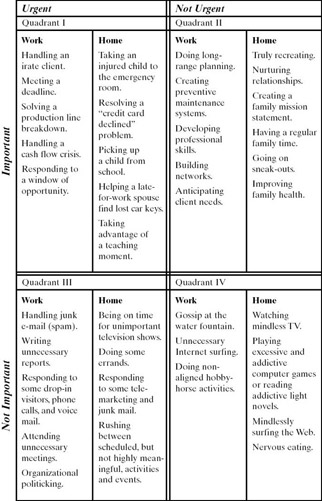Quadrant II
Over the years, we’ve found that one of the most significant challenges to focusing on what matters most—and to implementing some of the high leverage optimizers we’ve talked about—is the inability to discern between what is urgent (or apparently urgent) and what is truly important. For many, reacting to the urgent has become a way of life. It’s easy to get caught up in “urgency addiction,” getting our “highs” from handling crises. Unconsciously, without knowing it, we frequently make choices that keep us in a self- perpetuating crisis mode.
Aside from the impact of this kind of reactive lifestyle on health, personal productivity, and family relationships, the bottom line is that we waste a lot of time and energy on things that are pressing and proximate instead of working on what really matters most. In addition, we fail to integrate into our lives those things that have the highest quality of life-improving potential. But this all changes dramatically when we’re able to see life in terms of importance.
In previous works, we’ve shared how the power of this paradigm of importance can be captured in what we’ve come to call the “Time Management Matrix.” This matrix illustrates how we spend time in one of four different ways as defined by urgency and importance. In this version, we’ve listed some of the activities at work and at home that would fall into each of the four quadrants.
As we study this matrix, it becomes evident that the real “mother lode” in terms of effectiveness is in Quadrant II. The key is to learn to see life in terms of importance rather than urgency—to act based on principles and values rather than reacting to everything that’s coming at us with an “urgency” tag attached.
Many people find this matrix enormously helpful for at least four reasons:
-
It’s wonderfully descriptive. Many people say, “That’s exactly what happens to me! I get so caught up trying to solve crises and meet other people’s priorities (Quadrants I and III), I feel like I have to escape. So I stay up late watching some dumb show on TV or reading some mindless romance novel (Quadrant IV). Obviously, I need to handle the things in my life that are both urgent and important (Quadrant I), but I also see the enormous benefits that could come from investing time in important things like planning, preparing, recreating, and building relationships (Quadrant II) . . . even though they may not seem urgent at the time.”
-
It highlights the importance of proactivity. Clearly, the most aligned, high leverage optimizers in all areas of life are in Quadrant
II. They are important; but they aren’t urgent. They don’t act on us. As a result, we have to be highly proactive to choose to do them. Of course, we don’t have to do Quadrant II things. We don’t have to take our spouse on a date or read wisdom literature or go on a sneak-out with a child. We could wait until things move into Quadrant I—maybe our marriage is on the rocks, we’re in a severe state of confusion and depression, or we have a son or daughter on drugs—and then handle the crisis. But we could also be proactive and choose to invest in Quadrant II planning, preparation, and prevention instead. There’s no absolute guarantee that everything will work out just the way we want it to. But chances are a lot higher when we work to strengthen relationships and prevent crises rather than trying to salvage and repair what’s left.
THE TIME MANAGEMENT MATRIX -
It highlights the importance of investment and continuous improvement. It helps us understand the importance of working on the system as well as in it. It shows the value of investing time regularly in Quadrant II—where it will bring huge returns—instead of merely spending or wasting time in Quadrants III and IV. As we’ve said, quality family life is an achievement. It takes work. And much of the vital family work is done by investing in “important” but “not urgent” Quadrant II. The same is true of excellence on the job. You may become really good at managing by crisis and putting out fires. But investing in fire prevention will open the door to a whole new level of professional effectiveness.
-
It reveals where we can get the time to invest in Quadrant II. Obviously, we can’t neglect Quadrant I. It’s both urgent and important. But we can move out of Quadrants III and IV. Quadrant III is the biggest time waster at the office. Remember the research we cited in “Work Matters” revealing how much time at work is not focused on achieving the highest priorities. Quadrant IV is the biggest time waster at home. It’s an enormous temptation to just “crash” in front of the television instead of doing something worthwhile or truly rejuvenating. By becoming aware of time wasted in these quadrants, we can consciously choose to shift our “spending” habits and invest that time in Quadrant II, where it will bring greater returns. The key is to always live “above the line” that separates Quadrant I and II from Quadrant III and IV.
For these and other reasons, this Time Management Matrix is a valuable tool in helping people effectively handle time matters. (A complimentary Matrix evaluation tool is available at the Web site www.franklincovey.com/lifematters.)
EAN: 2147483647
Pages: 82